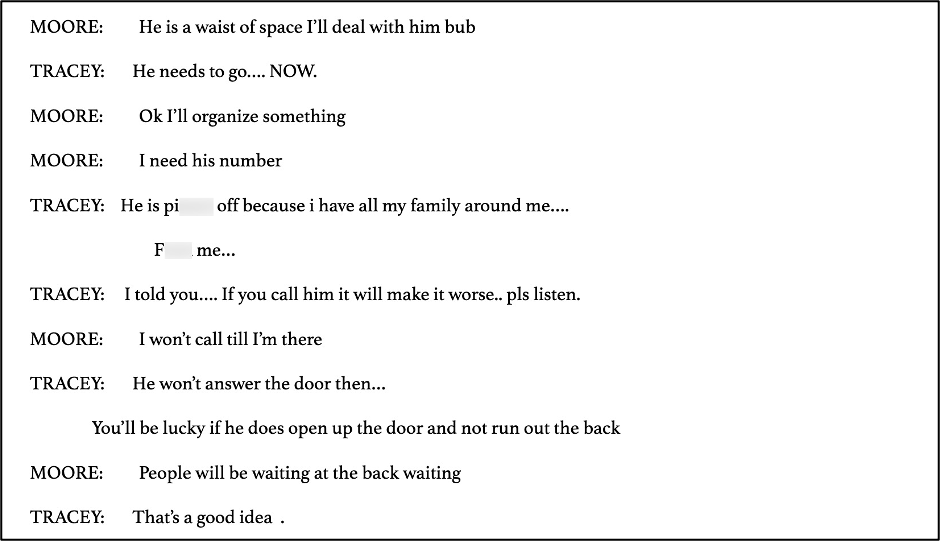
Digital Witness is Key to Queensland Mother’s Six-Year Journey to Justice
Debbie Goodlet and her eldest son, James, would talk nearly every morning on her drive to work; it was part of her daily routine. James would catch his mom up on work and life, with their favorite conversation piece being his 5-year-old daughter Alana’s latest milestones.
“He was the best dad in the world. He adored Alana,” Debbie said.
Yet, it had been a few days since they’d caught up. James’ dad, Albert, went to check on their son. Debbie then received a call that no mother is ever prepared to answer. “I answered, thinking it’d be James on the other end. Instead, it was Albert, and he told me that, ‘James is dead.’”
 Debbie managed to get her car safely to the side of the road to park and process the unthinkable. “We were both just like in shock, of course,” Debbie recalled. “He said, ‘Oh my God,’ he said. ‘Debbie, there’s just so much blood. There’s so much blood.’ He said, ‘Look, the police are here, I’ll ring you back.’”
Debbie managed to get her car safely to the side of the road to park and process the unthinkable. “We were both just like in shock, of course,” Debbie recalled. “He said, ‘Oh my God,’ he said. ‘Debbie, there’s just so much blood. There’s so much blood.’ He said, ‘Look, the police are here, I’ll ring you back.’”
Debbie then called James’ two younger siblings to break the news, that their brother was found dead in his Queensland home – with no sign of forced entry and so much blood. She told them it wasn’t immediately clear how he died, though police told the family it was “unusual.”
Little Alana, who was just shy of her sixth birthday, was with her mother, James’ ex-wife, Emily, at their home on Russell Island, off the coast of Queensland. Debbie delivered the devastating news. “Emily was hugging us and crying,” Debbie said. “We all sat around the table, and I said to Alana, a little 5-year-old, I said, ‘Do you know what it means, you know, when someone dies?’ And she said, ‘Yes, all your dreams come out of your heart and go away.’”
‘It Wasn’t Me’
During the investigation, police pulled Paul and Emily’s call detail records and “she gave an initial version, this initial version was essentially ‘No, no, it wasn’t me, wasn’t me, wasn’t me,’” said Adam Riley, a former Queensland Police Homicide Detective Sergeant on the case who now works at Cellebrite. “So then when we reviewed the call records in detail, we were able to put her within the vicinity of the scene.”

Suspects: Emily Jane Tracey and Paul Matthew Moore.
When they went back to Emily to discuss this development, her story changed. She then stated she was nearby but visiting her sick father up the street. Riley said her alibi did not check out – investigating police on the team were able to confirm that the nursing home staff never saw her visiting her father that night, she didn’t sign in to the visitors log either. Another lie.
With the lies, Riley and the team took a closer look at her phone, particularly her communications with her current partner, Paul Matthew Moore.
“We could see in their call charge records that they were in communication with each other a lot leading up to the offence,” Riley explained. “In the examination of her phone, we found that her device had been reset the phone a few hours prior to the offence.”
During the same time frame, the device in possession of Moore, was a newer model and a Full File System Extraction was unable to be obtained from his device. The communications that were evident in the call records, were not visible in the phone extractions.
“All of those comms were not there,” Riley said. “We could see they had been communicating, but they were not present on the devices. So that was the red flag. In addition, we didn’t know what that content on the communications was.”
“We were of the belief that there was no way on God’s green earth that James would have opened the door to Paul. So, the prosecution theory was that Emily had organized it,” Riley said, adding that the case against Paul was strong and the case against Emily, a bit weaker. Even with her web of lies, it was mostly circumstantial.
Determining the Crime
A week later, the autopsy confirmed James was murdered. Queensland Police suspected the 36-year-old was ambushed and stabbed in his home in February 2018. A week went by, and Debbie received nightly phone calls from the police updating her on the investigation. Alana turned six that week, and they did their best to celebrate her birthday – without her dad. Then Debbie got a call from the police the following day.
“We got a call that night to say that they’d arrested somebody. And the officer said, ‘you know them.’ I said ‘who?’ And he said that it was Emily. “I just lost the plot” Debbie said, “I was at home with my daughter, Courtney at the time, and she says she still suffers from PTSD. This is because I was screaming into her bedroom saying it was Emily, it was Emily, it was Emily.” Emily Jane Tracey had been charged with the homicide of James with an additional circumstance of aggravation that it was a domestic violence homicide. In addition to this, the police informed Debbie that Emily’s current partner, Paul Moore, had also been charged with the homicide of James.
Debbie immediately thought back to Emily crying into her arms, the day after the murder. “How cold of a person you must be to be able to do that to people. It’s just like inconceivable that, you know, that she just what was going on with life as normal.”
The Unbiased Witness Emerges: ‘He is a walking dead’
The first trial for this matter resulted in a mistrial due to some evidence led that defense objected to, and a mistrial was ordered. By the time the second trial rolled around, technology had advanced, particularly when it came to accessing devices. Riley, who had transitioned to his role at Cellebrite, had an idea: re-examine the phone to see if they can get a better extraction.
It worked – particularly in accessing the data on Paul’s phone.
“I opened it up with Physical Analyzer and all the deleted content from the full file system was visible in the extraction. It was all recovered. I just went, ‘Oh my God,’” Riley recalled.
Leading up to the murder, he found numerous instances of Emily and Paul talking about causing harm to James. When she complained about her ex-husband, Paul wrote back, ‘He is a walking dead.’ Police now had evidence to support the theory that Emily had counselled this murder.


In another social media message Paul sent to a friend, he wrote about James that he would “Belt the living s*** out of him then stab straight through the neck.”

“I rang the prosecutor directly and said, ‘Listen, I’m going to send you an Excel sheet. I haven’t completed my statement; or my evidence certificate or anything like that. I haven’t finalized my formal review, but I need you to send these for disclosure to the defence, and I need you to send them tonight,’ as I was due to give evidence the next morning,” Riley said.
Debbie was in court the next morning and watched Emily as she learned of the new evidence, “she was flicking through it and then she was crying real tears.”
The judge found the new digital evidence so damaging for Emily’s defense, he declared another mistrial.
“The first trial was eight days. The second trial was eight days. You know. It takes a toll on you,” Debbie said. Yet, she knew the new evidence would be pivotal in holding Emily accountable in a third trial. The evidence confirmed all they had suspected.
Preparing for a Third Trial: ‘No Stone Unturned’
The investigations team got to work. “We were basically we’re going to leave no stone unturned. We briefed the prosecutor, made sure he was aware of the strength of the evidence,” Riley said.
Emily’s version had again changed to state that she was now up at the scene, but had not gone to the front door, that she had stayed on her device in the car on Facebook.
They employed Cellebrite Pathfinder to look at all three devices simultaneously with the Crown Prosecutor requesting that he just needed the communications filtered down to James, Emily and Paul.
“We were able to review them and basically filtered down just to the communications between them, and we were able to really build a timeline of before and after the crime,” said Riley.
When we were reviewing the validity of her being in the car, we were able to see things a little more clearly than looking at them individually in the reader program Riley explains, “When you’re reviewing it in the Pathfinder timeline and you’re looking at what’s going on, she was actually on a boat at 10:42pm the night on the way back to Russell Island. And around that time, you see the very first instance of a Facebook application install on the freshly reset device in the timeline. So, all those artifacts sort of start to pop in. After this evidence revealed that Facebook was only installed post offence, it took away her latest version of events that she remained in the car.
“She changed her story while she was on the stand – just watching her spill lies every single moment,” Debbie recalled while saying that it felt like James was on trial for his own murder. “She was grasping at straws, trying to create this horrible image of James. He couldn’t defend himself. Everything that came out of her mouth was a lie.”
But the digital evidence spoke for itself – all the texts leading up to the murder. The messages she sent during it, and the fact that there was no Facebook usage until a long period after the offence had taken place.
Based on the overwhelming digital evidence provided by the prosecution, both Paul and Emily elected to provide evidence to try and account the communications. The prosecutor was able to successfully cross examine both defendants about the damaging material on the phones before the jury.
At the conclusion of the trial, the judge, as this was a judge only trial, found both Emily and Paul guilty of murder and sentenced them to life in prison.
A Final Appeal
“We would not have gotten a conviction for Emily. I believe100% that digital evidence is what sealed the deal,” Debbie said. After multiple rejected appeals to the highest court in the land, the case is now truly over, and after six long years, Debbie has some semblance of closure. “I think about James every day. I’ve got a picture of him just here.”
Debbie is now raising Alana, who is 13. “She’s just a typical kid, and that’s all we want. What else do you want for a child except to try and live a normal life and be a typical teenager with all the teenage problems,” Debbie said.
“She does have some memory, and we keep that memory alive by reiterating what she remembers and telling stories. She remembers she used to paint James’s fingernails. He’d go shopping even with painted fingernails,” Debbie recalled, with profound sadness. “The family’s never been the same. We’ll never be the same because we’re missing that one piece of our family, and we try to do what we can do to keep things good for Alana.”